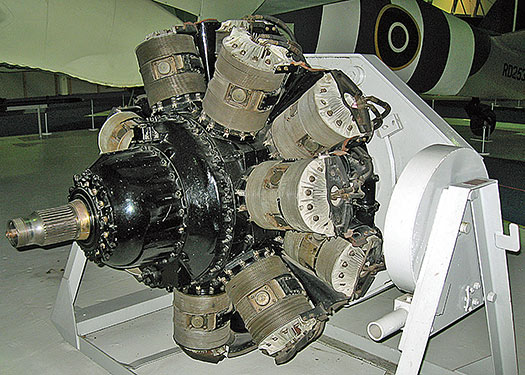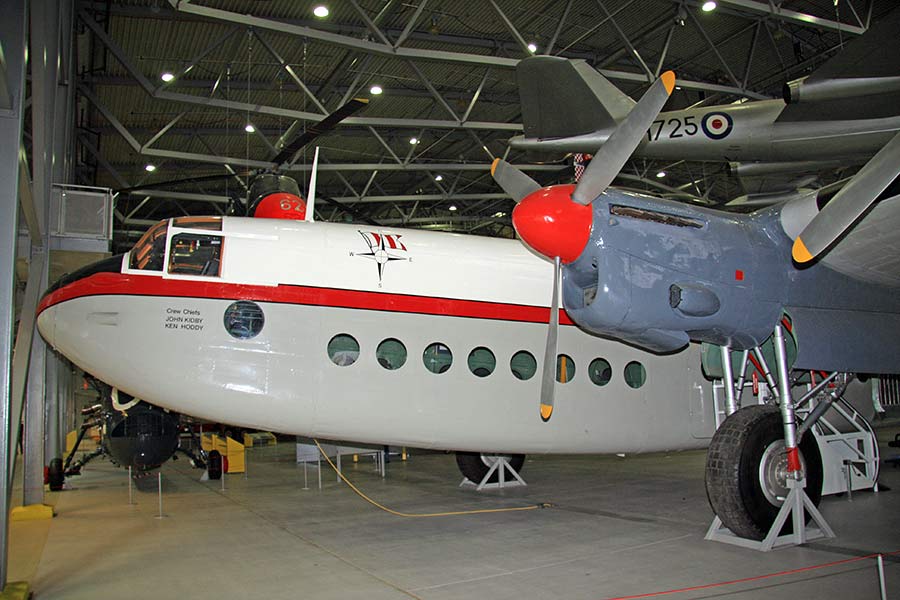

Avro York C.1 (TS798) [@ RAF Cosford]
In 1941, Avro designer Roy Chadwick began to sketch out a
long-range transport aircraft based on the Avro Lancaster and the result became
the Avro Type 685 York. In a remarkable
short time of only 5 months the prototype, LV626, flew on 5th July
1942 and was in fact later converted to the only C.II prototype powered by four
Bristol Hercules XVI radial piston engines [photograph -
below]. Prototype LV629 was fitted with
passenger seats, LV633 was fitted out as a flying conference room and the final
prototype LV639 was fitted as a paratroop drop variant with a drop hatch in the
floor. Incorporating the wings, tail, undercarriage and Merlin engines of the
Avro
Lancaster bomber but with a new square-section fuselage of much greater
capacity, the York was to prove a useful military and civilian transport
aircraft in war and peace. The increased fuselage side area forward of the wing
compared to the Lancaster necessitated fitting a third central fin to retain
adequate control and directional stability. The Avro York was initially produced only in small numbers
due to the shortages of materials and the need prioritise the
Lancaster, but the
type went into mass production in 1944 and 252 were eventually built (all Avro
except one was built by Victory Aircraft in Canada), of which 44 were the
York 1 civil
transport variant. During 1945 511 Squadron based at RAF Lyneham,
Wiltshire, became the
first squardron to receive a full complement. The York C.1 variant eventually
equipped nine squadrons at RAF Transport Command with 7 York squadrons being the
mainstay of the RAF contribution to the Berlin Airlift in 1948/49 flying 58,000
sorties, close to half of the British contribution, alongside the
Douglas Dakota
and Handley Page Hastings. In RAF Transport Command service the York was used on
the England – India route. The
Handley Page Hastings
had replaced the RAF York by
the early 1950s with many ex-RAF C.1s subsequently passing into civilian hands. Production of the type ceased on the 29th April 1948.
TS798 was built by Avro at Yeadon, Yorkshire, for RAF/BOAC
use. The first flight of TS798 was on the 19th October 1945 at
Yeadon and was delivered to BOAC at Croydon Airport on the 8th
November 1945 in overall silver with RAF roundels. Surplus to RAF
requirements TS798 was issued with a civil registration, G-AGNV, on the 9th
December 1945 and initially used for training by BOAC. TS798 then entered
scheduled BOAC service as “Morville” on the Calcutta route on the 1st
February 1947. When BOAC withdrew Yorks from passenger service during
1949/50 TS798 was converted into to a freight variant with double freight doors
on the port side and was operated by BOAC from London Heathrow. On the 30th
March 1955 TS798 was sold to Skyways Ltd for tour and charter work and operated
from Stansted and Heathrow. LaterTS798 was used for carrying spare engines
around the world for Skyways' own Lockheed Constellations as well as BOAC and
Pan American Airways aircraft. TS798 retired from use as Skyways' last
York during May 1964 and was temporally placed into storage at Luton. Sold
to the Skyfame aircraft collection on the 9th October 1964, TS798
made the last flight ever by an Avro York by flying from Heathrow to Staverton
Airport, Gloucestershire. During the flight TS798 was escorted by 2
Handley Page Hastings
from 24 and 36 Squadrons RAF Colerne, Wiltshire. In the spring of 1965
TS798 was painted in the markings of prototype LV633 `Ascalon' to represent the
York used by Winston Churchill and King George VI during the war.
Purchased by the museum on the 16th May 1972 and was transferred to
RAF Brize Norton by road for restoration. During the restoration TS798 was
repainted (see photograph) in the livery of “MW100”, the first production York,
which was delivered to 24 Squadron RAF in 1943 and served as a VIP aircraft.

During WW2 the York also served as a VIP transport
aircraft. Prototype, LV633 (Ascalon) was customised as the personal transport
and flying conference room for Prime Minister Winston Churchill. Delivered to 24
Squadron at RAF Northolt in March 1943 LV633 carried Churchill to Algiers in May
and just a few days later it carried George VI for his first visit to troops in
North Africa. LV633 was to be fitted with a
pressurised "egg" so that VIP passengers could be carried without having to use
oxygen masks. Testing at RAE Farnborough found the "egg" to work well; however
Avro stated it was too busy with the new Avro Lincoln so the “egg” was never
installed. MW140 (Endeavour) flew to Australia in 1945 to become the personal
aircraft of Australia's then Governor-General, HRH The Duke of Gloucester. Operated
by the Governor-General's Flight from 1945 to 1947 MW140 was the only York to be
operated by the RAAF. Another York, MW102 was fitted out as a "flying office"
for the use of the Viceroy of India and C-in-C South East Asia Command, Lord
Mountbatten. On the 14th November 1944 Air Chief Marshal Sir Trafford
Leigh-Mallory was killed when his York, MW126, struck a ridge in the French Alps
during a blizzard. He was on his way to Ceylon to take command of the Allied air
operations in the Pacific. In addition, the South African leader Jan Smuts also
used a York, ZS-DGN, as his personal transport as did General De Gaulle. When the Distant Early Warning Line (Dew Line or Early
Warning Line) was being constructed in Canada in the late 1950s, the York was
introduced as a freighter by Associated Airways. At least one, CF-HAS, was
retained and remained in service with Transair until 1961. The DEW Line was a
system of radar stations in the far northern Arctic region of Canada, with
additional stations along the North Coast and Aleutian Islands of Alaska, in
addition to the Faroe Islands, Greenland, and Iceland. It was set up to detect
incoming Soviet bombers during the Cold War and provide early warning of any
sea-and-land invasion. The line was operational from 1957 to the late 1980s and was
most capable of the three radar lines in Canada and Alaska.


Avro York C.1 (MW232) [@ RAF Duxford]
The first civilian York 1, which was initially built for the RAF
as MW103, was delivered from Ringway to British Overseas Airways Corporation
(BOAC) in February 1944 as G-AGJA. A further four Yorks were delivered to BOAC
from April 1944 and a further 20 being delivered from August 1945
for Joint operations with RAF transport command. Twelve were built for the
British South American Airways Corporation, five for FAMR of Argentina and two
for Skyways Air Freight. BOAC Yorks took over the Shorts Empire Class flying boat routes
from Cairo to Durban in late 1946. British South American Airways (BSAA)
operated the York on their routes to South America until their merger into BOAC
in September 1949. The York performed airliner services in the same era as the
Boeing Stratocruiser, Convair 240 & 340 and the Douglas DC6. The type seated 24
passengers and was powered by four 1620hp Merlin 502 engines which provided a
210mph cruising speed. BOAC operated freight schedules until November 1957 but
the type flew on with Skyways and Dan Air London until 1964. Skyways Air
Freight became the largest York operator with 30 aircraft by
purchasing additional ex-RAF York C.1s.
Built at Yeadon, Yorkshire, MW232 entered RAF service with 242
Squadron in August 1946. During May 1947 MW232 was transferred to 511
Squadron which was based at RAF Lyneham and was used for trooping and cargo
flights, including flights to the Far East. 511 Squadron became the first
squadron to operate the Avro York transport and operated then until September
1949 when the squadron was re-equipped with the
Handley Page Hastings
C.1. MW232 flew in the Berlin Airlift (24th June 1948 to 12th
May 1949) and had the distinction of carrying the 100,000th ton of
supplies into the city. Following an undercarriage collapse during a
landing in January 1949 MW232 was repaired and then placed into storage.
During May 1950/51 MW232 was used by the Fairey Aviation for flight refuelling
research before being transferred to 12 MU at RAF Kirkbride, Cumbria, for
storage waiting disposal. In 1954 MW232 was purchased by Dan Air and
registered as G-ANTK and was used for freight work until retirement in May 1964.
Based at Blackbushe until its closure to commercial airlines MW232 then moved to
Gatwick in 1960. MW232 was mainly used on long-range freight charters to
Africa and the Far East, including many flights under a MoD contract to the
Woomera Rocket Range in Australia. G-ANTK became the last operational Dan
Air York and flew the last commercial flight on the 23rd April 1964.
On the 30th April 1964 MW232 was ferried to Lasham Airfield,
Hampshire, to be used as a bunk house by the local Air Scouts until 1974.
Initially the Dan Air preservation group began to restore MW232 but the project
was too extensive so on the 23rd May 1986 MW232 was transferred in
sections to the Duxford Aviation Society by road for restoration.